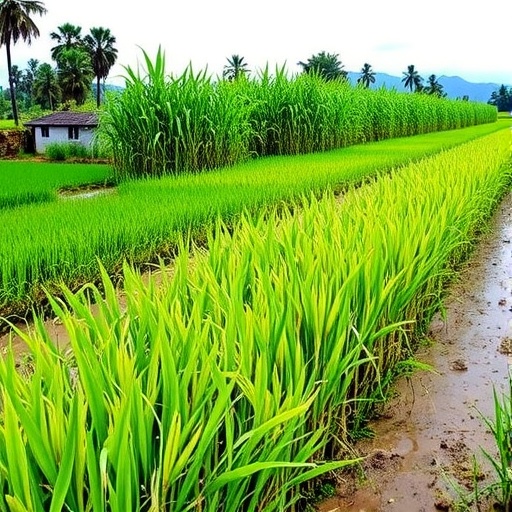In the realm of agricultural science, researchers continuously search for innovative methods to enhance crop management and yield potential. One area of focus is the estimation of leaf area index (LAI), an important parameter that helps gauge canopy health and productivity. Traditionally, measuring LAI has involved labor-intensive and destructive sampling methods, which are not viable for large-scale applications or long-term monitoring. A groundbreaking study conducted by Fukuda et al. presents a novel, non-destructive approach to accurately estimate rice canopy LAI through the use of Near-Infrared (NIR) and Photosynthetically Active Radiation (PAR) measurements. This study not only advances scientific understanding but also holds significant implications for precision agriculture.
The study evaluates four distinct rice cultivars, each characterized by varying leaf traits and plant architectures. This diversity in genetic makeup offers a rich platform for understanding how different rice types respond to varying environmental stimuli. NIR and PAR technologies utilize wavelengths of light that interact differently with plant materials. These interactions allow researchers to glean information about biomass and structure without compromising the plants themselves. In essence, this non-destructive technique leverages light as a tool to assess growth parameters effectively.
By analyzing data obtained from different rice cultivars, the researchers could identify unique patterns correlating LAI with certain spectral signatures. The variations in leaf angle, thickness, and surface area among the cultivars contributed to the differential absorption and reflection of light. Such findings underscore the importance of tailoring remote sensing technologies to specific crop types. The study emphasizes that while some methodologies may work universally, others require refinement to accommodate the natural diversity present in crop species.
Ergonomic concerns related to rice cultivation are increasingly influencing research approaches—especially as global food demands rise. Through the lens of this study, a more strategic assessment of crop development is possible. The innovative use of NIR and PAR ensures that farming practices can evolve from reactive to proactive, effectively allowing farmers to maximize crop health and yield before adverse conditions arise. Improved LAI tracking through this method could provide actionable insights into optimal irrigation and fertilization strategies, further enhancing agricultural productivity.
One of the compelling aspects of Fukuda et al.’s research is its potential for scalability. As agricultural production must keep pace with the growing global population, the adoption of non-destructive measures in LAI estimation could revolutionize farming practices on a broader scale. Through remote sensing, large areas of crops could be analyzed swiftly, producing rich datasets for optimal growing conditions and crop management. Additionally, integrating these methodologies with modern technologies such as drones and satellite imaging could provide even greater analytical clarity.
Economically, moving towards this non-destructive estimation methodology has the potential to significantly reduce labor costs and resource expenditure. Traditional methods require extensive manual processes, often leading to increased operational costs and time inefficiencies. The shift to effective remote sensing not only streamlines the workflow but also allows farmers to allocate resources more effectively, potentially leading to better financial outcomes.
Moreover, the implications of this research extend beyond economics. Aligning agricultural practices with sustainable methods is paramount for environmental conservation. The non-destructive nature of this measurement technique supports sustainability goals by minimizing plant damage and microenvironment disruption. Furthermore, accurate LAI estimations may enable precision agriculture strategies that optimize resource use, thereby reducing the ecological footprint of farming.
Integrating the findings of this study into broader agricultural initiatives might also foster multidisciplinary collaboration—uniting plant science, engineering, and data analytics. As precision agriculture continues to evolve, the insights garnered from NIR/PAR interactions will be crucial in developing smart agricultural systems that can monitor and manage crops efficiently. Future research could build upon these findings by exploring various conditions under which these non-destructive methods perform best and examining their applicability to other crops and agricultural contexts.
Despite its numerous advantages, the study does not shy away from the complexities involved in transitioning to these technological advancements. A significant challenge in measuring LAI using NIR and PAR lies in understanding how environmental factors like light intensity and atmospheric conditions impact spectral readings. Thus, ongoing research must focus on calibrating equipment and methodologies to ensure reliable data across varied conditions. Addressing these challenges is essential for encouraging wider acceptance and implementation of non-destructive LAI estimation practices in mainstream agriculture.
The research team’s commitment to scientific rigor is evident in their methodology, which combines field studies with sophisticated data analysis. By utilizing statistical models to interpret the relationships between spectral data and LAI, the findings illustrate a solid framework for future agricultural research. As a result, the research not only enhances existing knowledge but lays the groundwork for further innovation in crop measurement technologies.
In conclusion, Fukuda et al.’s pioneering work exemplifies the potential of using advanced spectral technologies for non-destructive LAI estimation in rice crops. Given the global imperative for sustainable food production, this research could significantly impact how farmers monitor crop health and productivity moving forward. By leveraging a combination of cutting-edge technology and agricultural expertise, the study signifies a positive step toward marrying advanced science with practical farming applications—ensuring that agricultural productivity can meet future demands without compromising the integrity of our natural resources.
As we look to the future, embracing strategies that enhance accuracy, efficiency, and sustainability will be key drivers in the agricultural industry. This study serves as an important reminder that with the right tools and methodologies, progressive agricultural practices are within reach, ultimately leading to better harvests and improved food security for generations to come.
Subject of Research: Non-destructive estimation of rice canopy LAI
Article Title: Non-destructive estimation of rice canopy LAI using NIR/PAR: application to four rice cultivars with diverse leaf characteristics and plant architectures.
Article References:
Fukuda, S., Okamura, M. & Sugiura, D. Non-destructive estimation of rice canopy LAI using NIR/PAR: application to four rice cultivars with diverse leaf characteristics and plant architectures.
Discov Agric 3, 153 (2025). https://doi.org/10.1007/s44279-025-00343-z
Image Credits: AI Generated
DOI:
Keywords: Non-destructive estimation, rice canopy, LAI, NIR, PAR, precision agriculture, remote sensing, agricultural sustainability.




